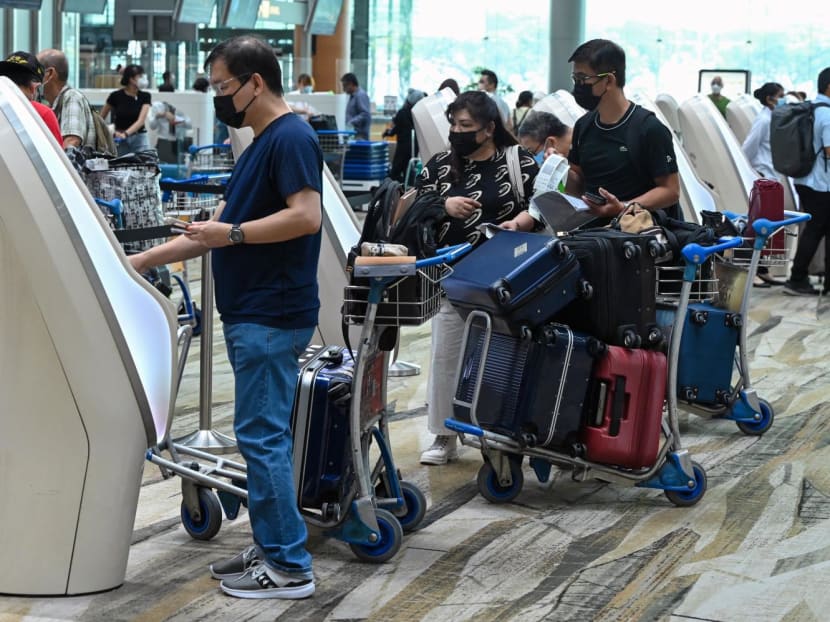Cleaner energy, improved navigation tools: How the airport and air traffic management sectors will reduce emissions
SINGAPORE — Reducing energy use from air-conditioning in airport terminal buildings, using cleaner energy sources for airside vehicle fleets and enhancing air traffic management tools.

Travellers register for self check-in before departure at Singapore Changi Airport in Singapore on April 1, 2022.

This audio is AI-generated.
SINGAPORE — Reducing energy use from air-conditioning in airport terminal buildings, using cleaner energy sources for airside vehicle fleets and enhancing air traffic management tools.
These are among the initiatives that will be implemented under the airport and air traffic management domains as part of Singapore's sustainable air hub blueprint.
The blueprint, which was developed by the Civil Aviation Authority of Singapore (CAAS), was launched on Monday (Feb 19) by Transport Minister Chee Hong Tat at the Changi Aviation Summit.
CAAS will work on rolling out a suite of initiatives across three domains — airline, airport and air traffic management — to decarbonise Singapore's aviation sector while supporting its sustainable growth.
Under the airline domain, CAAS will require flights departing Singapore to use sustainable aviation fuel from 2026. Passengers can expect to pay an additional levy on their air tickets.
Singapore aims to reduce domestic aviation emissions from airport operations by 20 per cent from 2019 levels by 2030. The emissions targets exclude Changi East developments, including Terminal 5, as these are not yet operational today.
Singapore also aims to achieve net-zero domestic and international aviation emissions — inclusive of emissions from international flights operated by Singapore-based operators — by 2050.
“Our approach is to enable the aviation sector to grow and achieve environmental sustainability concurrently — not choosing one or the other, but we want both — so that future generations can continue to enjoy the benefits of flying,” said Mr Chee.
“Aviation is a key enabler for the global economy, connecting businesses and people — it brings the world closer together. Hence, the future of aviation must continue to be a story of growth, balanced with sustainability. Good for people, good for businesses, good for the environment.”
AIRPORT: REDUCING ENERGY CONSUMPTION, USING RENEWABLES
CAAS will roll out five initiatives to reduce energy use and deploy renewables at Changi Airport under the airport domain in the blueprint.
First, it will work with the Changi Airport Group (CAG) to install more solar photovoltaic systems on available rooftop spaces of airport buildings to increase solar power deployment at Changi Airport and Seletar Airport. It will also study the feasibility of airfield solar deployment.
As of the end of 2023, Changi Airport had the capacity to generate close to 4 per cent of its 2019 electricity consumption. Plans to install more solar photovoltaic systems on available rooftop spaces will generate a further 6 per cent.
Solar panels will also be rolled out at Seletar Airport.
Second, Changi Airport will aim to have its entire airside vehicle fleet operate on cleaner energy sources by 2040.
It is also aiming to have all new light vehicles — such as cars, vans and minibuses — and selected new heavy vehicles like forklifts and tractors to be electric from 2025. Additional charging stations will also be installed.
Third, CAAS will work with CAG and other airport partners to continually improve the energy efficiency of Changi Airport's terminal buildings.
The airport's air-conditioning systems, which account for more than half of the buildings' total electricity consumption, will be a focal point here.
Changi Airport is currently pursuing the use of heat-reflecting facade materials to lower energy use from air-conditioning, on top of upgrading the chiller systems in the terminal buildings.
Fourth, Changi Airport will adopt low-carbon electricity imports as part of the Energy Market Authority's plans to reduce Singapore's national grid emission factor.
Currently, most of the carbon emissions from airport operations are produced by electricity consumption at the airport.
Fifth, CAAS will work with stakeholders to study the feasibility of an on-site waste-to-energy facility at Changi Airport. This could turn waste into a feedstock to generate electricity or biofuel for use within the airport.
AIR TRAFFIC MANAGEMENT: INCREASING EFFICIENCY, REDUCING FUEL BURN
At the same time, CAAS will work with stakeholders and partners on three initiatives to improve air traffic management operations to increase efficiency and reduce fuel burn over the next five years.
First, it will enhance the management of air traffic in terms of available capacity.
This includes improving the coordination and management of longer-haul flights, as well as enhancing the reliability, timeliness and accuracy of weather forecast information provided to air traffic controllers through the use of predictive tools to support decision-making.
Second, it will enhance performance-based navigation by collaborating with air navigation service providers in the region to implement "more direct routings on a wider scale".
In the longer term, it will work towards introducing free route airspace to bring about optimised capacity and flexible flight trajectories.
CAAS will also develop smart tools to help with the optimisation of descent flight profiles within Changi Airport — which will reduce fuel burn and emissions.
Third, CAAS will work towards gate-to-gate trajectory optimisation. It will implement a "decision support tool" to optimise the departure intervals between aircraft, enhancing runway efficiency.
These three initiatives are collectively expected to result in a 10 per cent reduction in additional fuel burn and emissions. CNA
For more reports like this, visit cna.asia.








